Sie müssen alle WordPress-Plugins deaktivieren, können aber nicht auf den WordPress-Adminbereich zugreifen?
Bei der Fehlersuche in WordPress wird Ihnen oft geraten, alle Plugins zu deaktivieren und dann eines nach dem anderen wieder zu aktivieren. Was aber, wenn Sie nicht auf wp-admin zugreifen können, um sie zu deaktivieren?
In diesem Artikel zeigen wir Ihnen, wie Sie ganz einfach alle WordPress-Plugins deaktivieren können, wenn Sie keinen Zugriff auf den wp-admin-Bereich haben.
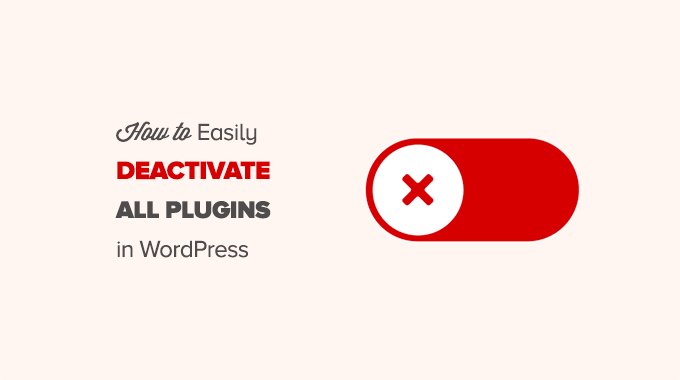
Video-Anleitung
Wenn Sie eine schriftliche Anleitung bevorzugen oder in Ihrem eigenen Tempo vorgehen möchten, lesen Sie bitte die nachstehenden Anweisungen weiter.
Es gibt zwei gängige Methoden, um Plugins zu deaktivieren, ohne auf den Admin-Bereich Ihrer WordPress-Website zuzugreifen. Sie können die Methode wählen, die Ihnen einfacher erscheint:
Methode 1: Deaktivieren Sie alle WordPress-Plugins per FTP
Für diese Methode müssen Sie entweder einen FTP-Client oder die Dateimanager-App in Ihrem WordPress-Hosting-Kontrollpanel verwenden.
Wenn Sie noch nie mit FTP gearbeitet haben, sollten Sie sich unseren Leitfaden zum Hochladen von Dateien in WordPress mit FTP ansehen.
Zunächst müssen Sie mit einem FTP-Client oder dem Dateimanager im cPanel eine Verbindung zu Ihrer Website herstellen. Sobald Sie verbunden sind, müssen Sie zum Ordner /wp-content/ navigieren.
Innerhalb des Ordners wp-content finden Sie einen Ordner namens plugins. Hier speichert WordPress alle Plugins, die auf Ihrer Website installiert sind.
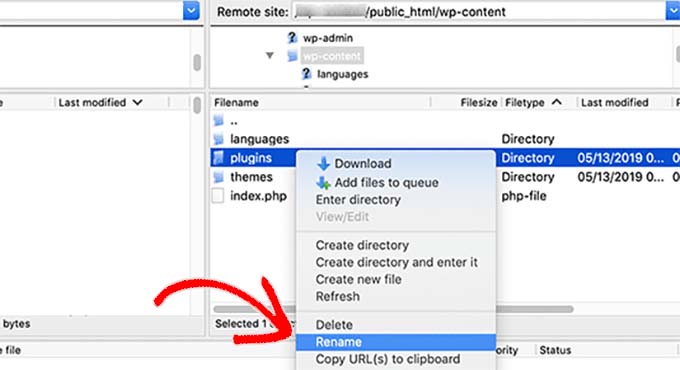
Klicken Sie mit der rechten Maustaste auf den Plugins-Ordner und wählen Sie „Umbenennen“.
Als Nächstes ändern Sie den Namen des Ordners nach Belieben. In unserem Beispiel werden wir ihn plugins.deactivated nennen.
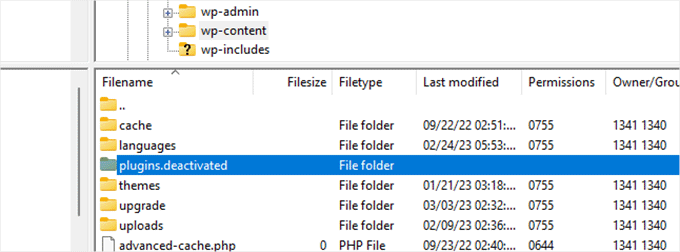
Sobald Sie dies tun, werden alle Ihre Plugins deaktiviert.
Das liegt daran, dass WordPress nach einem Ordner namens „Plugins“ sucht, um die Plugin-Dateien zu laden. Wenn es den Ordner nicht findet, deaktiviert es automatisch die aktiven Plugins in der Datenbank.
Diese Methode wird in der Regel verwendet, wenn Sie aus Ihrem Verwaltungsbereich ausgesperrt sind. Wenn das Problem mit Ihren Plugins zusammenhängt, sollten Sie sich in den WordPress-Administrationsbereich einloggen können.
Wenn Sie die Seite Plugins “ Installierte Plugins im WordPress-Administrationsbereich besuchen, sehen Sie Benachrichtigungen für alle Plugins, die deaktiviert wurden.
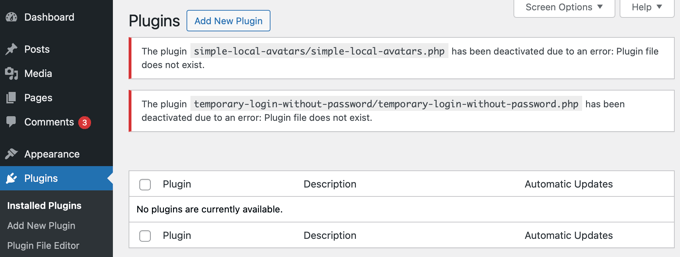
Sie werden auch feststellen, dass alle Ihre Plugins jetzt verschwunden sind. Keine Sorge, sie sind alle sicher, und Sie können sie leicht wiederherstellen.
Wechseln Sie einfach wieder zu Ihrem FTP-Client und gehen Sie zum Ordner /wp-content/. Von hier aus müssen Sie den Ordner “ plugins.deactivated “ wieder in "plugins" umbenennen.
Nun können Sie zur Seite Plugins “ Installierte Plugins im WordPress-Administrationsbereich zurückkehren und ein Plugin nach dem anderen aktivieren, bis Ihre Website wieder funktioniert.
Jetzt wissen Sie genau, welches Plugin das Problem verursacht hat. Sie können dann den Ordner dieses Plugins per FTP von Ihrer Website löschen oder den Autor des Plugins um Unterstützung bitten.
Methode 2: Deaktivieren Sie alle Plugins mit phpMyAdmin
Die FTP-Methode ist unserer Meinung nach definitiv einfacher. Sie können aber auch alle WordPress-Plugins mit phpMyAdmin deaktivieren.
Wichtig: Bevor Sie irgendetwas tun, machen Sie bitte eine vollständige Datenbanksicherung. Dies wird sich als nützlich erweisen, wenn etwas schief geht.
Als nächstes müssen Sie sich bei Ihrem Webhosting-Dashboard anmelden. In diesem Beispiel zeigen wir Ihnen ein cPanel-Dashboard. Das Dashboard Ihres Hosting-Kontos kann anders aussehen.
Klicken Sie auf das Symbol „phpMyAdmin“ unter dem Abschnitt Datenbanken.
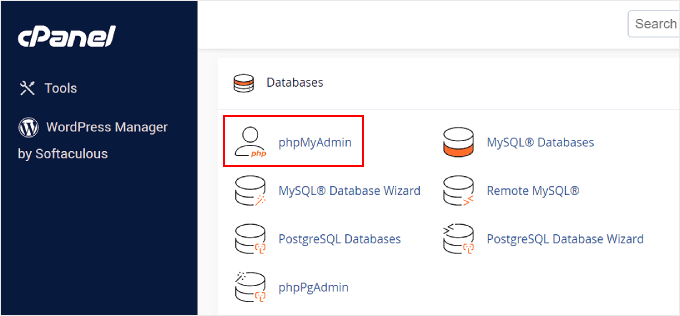
Dadurch wird phpMyAdmin in einem neuen Browserfenster gestartet.
Sie müssen Ihre WordPress-Datenbank auswählen, wenn sie nicht bereits ausgewählt ist. Danach können Sie die WordPress-Datenbanktabellen sehen.
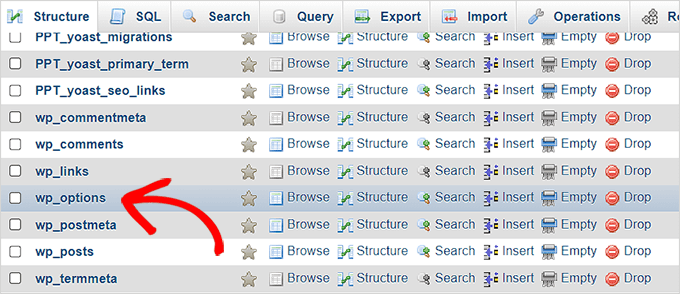
Wie Sie sehen können, haben alle Tabellen in der Datenbank das Präfix wp_ vor dem Tabellennamen. Ihre Tabellen können ein anderes Datenbankpräfix haben.
Sie müssen auf die Tabelle wp_options klicken. In der Tabelle wp_options sehen Sie Zeilen mit verschiedenen Optionen. Suchen Sie die Option „active_plugins“ und klicken Sie dann auf den Link „Bearbeiten“ daneben.
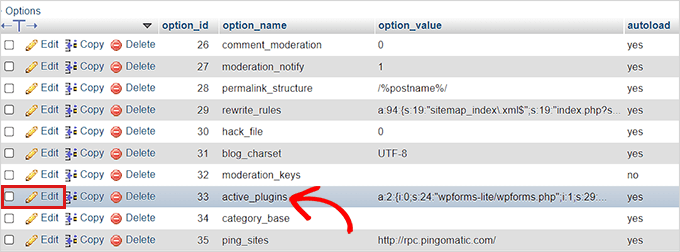
Auf dem nächsten Bildschirm müssen Sie das Feld option_value in a:0:{} ändern.
Klicken Sie dann auf die Schaltfläche „Go“, um Ihre Änderungen zu speichern.
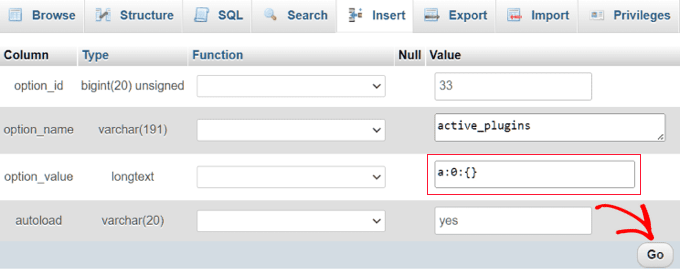
Sie haben alle WordPress-Plugins mit phpMyAdmin erfolgreich deaktiviert. Wenn ein Plugin Sie daran gehindert hat, auf den WordPress-Admin zuzugreifen, dann sollten Sie sich jetzt anmelden können.
Expertenanleitungen zu WordPress-Plugins
Nun, da Sie wissen, wie Sie Plugins deaktivieren, wenn Sie nicht auf wp-admin zugreifen können, möchten Sie vielleicht einige andere Anleitungen zu WordPress-Plugins sehen:
- Was sind WordPress-Plugins? Und wie funktionieren sie?
- Wie man WordPress-Plugins einfach deaktiviert (Anleitung für Anfänger)
- Wie man WordPress-Plugins von der Datenbank aus aktiviert/aktiviert
- Verlangsamen inaktive Plugins WordPress? Sollten Sie sie löschen?
- Wie viele WordPress-Plugins sollten Sie installieren? Was ist zu viel?
- Ist es sicher, veraltete WordPress-Plugins zu verwenden? (Erläutert)
- Sollten Sie Plugins installieren, die nicht mit Ihrer WordPress-Version getestet wurden?
- Wie man WordPress-Plugins richtig aktualisiert (Schritt für Schritt)
- Sollte ich zuerst WordPress oder Plugins aktualisieren? (Richtige Update-Reihenfolge)
Wir hoffen, dass dieser Artikel Ihnen geholfen hat, alle Plugins in WordPress zu deaktivieren. Vielleicht möchten Sie auch erfahren, wie Sie Google Analytics-Ziele ein richten oder sich unsere Liste der besten WordPress-Backup-Plugins ansehen, um Ihre WordPress-Daten sicher zu halten.
Wenn Ihnen dieser Artikel gefallen hat, dann abonnieren Sie bitte unseren YouTube-Kanal für WordPress-Videotutorials. Sie können uns auch auf Twitter und Facebook finden.




Syed Balkhi says
Hey WPBeginner readers,
Did you know you can win exciting prizes by commenting on WPBeginner?
Every month, our top blog commenters will win HUGE rewards, including premium WordPress plugin licenses and cash prizes.
You can get more details about the contest from here.
Start sharing your thoughts below to stand a chance to win!
Jiří Vaněk says
Thank you for the instructions using phpMyAdmin. I was always used to deactivating plugins via FTP, but it’s great to know other options in case I can’t access FTP. Great job.
WPBeginner Support says
Glad we can share another method in case it is ever needed
Admin
Hollie says
Thanks so much for writing this article- it saved me!
Big help, thank you!!
WPBeginner Support says
You’re welcome!
Admin
Alan says
I tried to deactivate my plugins using the FTP process on WordPress version 6.3, and the website crashed.
I was able to rename the plugins file and restart it okay. Just letting you know.
WPBeginner Support says
Thank you for letting us know, it would depend on the specific error message for what could have happened but glad to hear you were able to fix the issue!
Admin
Nick says
In the article it says;
On the next screen, you will need to change the option_value field to a:0:{.
Which I think should be a:0:{}
WPBeginner Support says
Thank you for pointing out that typo, we’ve updated the article to fix it!
Admin
Tamara says
I have changed the file name in FTP as suggested and am able to log into the WordPress admin, but as soon as I change the file name back to the original, the error comes back. Which means I am not able to deactivate / reactivate plugins one at a time.
Can you help?
WPBeginner Support says
In that case, you would want to use the second method from the article and that should force the plugins to deactivate.
Admin
Dr. Ashutosh Pradhan says
Thanks a lot for the information. I had activated Google reCaptcha v3 in Ultimate Member and was not able to login to the wp-admin using super admin details. I just renamed the directory recaptcha under directory plugin from FTP and the trick worked, it allowed me to login and disable Google reCaptcha v.3 from dashboard. Thanks a ton.
WPBeginner Support says
Glad our article was able to help!
Admin
Carol J Dunlop says
Thank you for this post and all the options. I did the PHPmyadmin one before but this time I just renamed the plugin file in cpanel. So much easier and faster and it triggered a „database repair“ notice. I did that and found that my Options table had crashed. I renamed the plugins file back to the original and ran the repair database again and it worked fine!
WPBeginner Support says
Glad to hear our recommendations helped and you were able to solve the problem
Admin
Jeroen says
I had a problem with my Jetpack plugin after I upgraded my PHP and WP. It would not let me deactivate or delete it. I went in the WP plugin folder and renamed the Jetpack plugin folder. Refreshed the plugin admin page in WP and Bob’s your uncle! I deleted the plugin through the admin panel and removed the folder from the root.
WPBeginner Support says
Glad you were able to solve the issue
Admin
Ashley says
I wasn’t having luck with either method but I found a backup from the day before which worked fine.
WPBeginner Support says
Thank you for sharing that, restoring from a backup when able is a good option to use
Admin
Katy Espiritu says
It solved my problem. I was able to log in to the admin site of word press again. Thank you so much. You are a blessing.
WPBeginner Support says
Glad our guide was helpful
Admin
Tom says
Hi, I did not install any plugins recenty, the only thing i did I changed the email.When I finished the process few hours later I could not enter The Dasboard (Sorry, you are not allowed to access this page). Any solutions Ty
WPBeginner Support says
If the recommendations in this article were unable to assist you, we would recommend taking a look at our article below:
https://www.wpbeginner.com/beginners-guide/beginners-guide-to-troubleshooting-wordpress-errors-step-by-step/
Admin
Chris says
Thank you very much, this helped a lot!
WPBeginner Support says
Glad our guide was helpful
Admin
Tahmid Hasan says
It is really working… Thanks a lot
WPBeginner Support says
You’re welcome
Admin
Sheila says
LIFESAVER! Thank you so much for this content! It worked in an instant and I’m back into my Admin dashboard!
WPBeginner Support says
Glad our guide was helpful
Admin
ANDERSON CARVALHO says
THANK YOU!!!!!!!!!!!!!!!!
WPBeginner Support says
You’re welcome
Admin
Tife says
Thanks so much
Second option work better
WPBeginner Support says
You’re welcome, glad our article was helpful
Admin
S K Shrivastava says
2nd one is really useful
WPBeginner Support says
Glad you found our guide helpful
Admin
Steph says
Unfortunately, both of these options did not help (still get error saying site is experiencing technical difficulties) after doing a plugin update (also updated wordpress 5.4 yesterday? could that be the culprit?)
WPBeginner Support says
For that error message, you would want to go through our guide below:
https://www.wpbeginner.com/wp-tutorials/how-to-fix-the-wordpress-white-screen-of-death
Admin
Dex Antikua says
My issue got solved easily by following the steps.
WPBeginner Support says
Glad our guide was able to help
Admin
Jimmy says
Thanks a lot for this help, it’s very easy to follow and it works so well
WPBeginner Support says
You’re welcome glad our guides are helpful
Admin
mika says
Thank you so much! it works!
WPBeginner Support says
Glad our guide was able to assist
Admin
Aditi Pygude says
Hello,
I need a help. whenever i tried to access my website I got download option. I tried your all above suggestions but it’s was’nt work for me. I renamed my plugin folder in my cpanel as plugin.deactivate after that I did changes in phpmyadmin in wp-options I edited active plugin folder . still I got download option. what should I do now .
Thanks in advance.
WPBeginner Support says
You would want to check with your hosting provider as well as go through the recommendations in our troubleshooting guide here: https://www.wpbeginner.com/beginners-guide/beginners-guide-to-troubleshooting-wordpress-errors-step-by-step/
Admin
anurag saxena says
Hello , tried your suggestion but i am unable to alogin into my wordpress admin area.any other suggestion?this is emergency.
WPBeginner Support says
If this does not specifically solve your issue, you would want to take a look at our guide here: https://www.wpbeginner.com/beginners-guide/beginners-guide-to-troubleshooting-wordpress-errors-step-by-step/
Admin
sourabh upadhyay says
very very very good saved my problem
WPBeginner Support says
Glad you found our article helpful
Admin
Ethel says
very helpful, thank you, worked like a charm.
WPBeginner Support says
Glad our article was helpful
Admin
Jerry says
I want to install the Yoast SEO plugin in wordpress. After I do that I need to Deactivate the plugin currently used, correct? I am new to working with WordPress and I need to do this on my own since the guy that made my website abandoned helping me any further! Any Help would be so Much appreciated! Thanks!
WPBeginner Support says
You would only need to remove your other plugin if it is an SEO plugin. If it is then you would want to remove it to prevent some common issues.
Admin
Megan says
Omg! You guys saved the day! Thank you so much! After I have spent so much time trying to get my site fixed your easy to follow guide had it fixed in minutes. So thank you!
WPBeginner Support says
Glad our guide could help resolve the issue
Admin
Aluko Kehinde says
Hi,
When I go to my website or the wp-admin page, my browser tries to download a file instead of displaying the page.
WPBeginner Support says
If disabling your plugins didn’t help, you would want to reach out to your hosting provider and they should be able to assist with that issue
Admin
israr777 says
Hi Wpbeginner Support,
How i should i deactivate all plugins in local site ?
WPBeginner Support says
You would rename the plugins folder on your computer for that
Admin
Mig Hu says
Thanks a lot – this is a site saver!
Quick question: after the plugin folder is renamed, when go back in the wordpress WP – admin back office plugins list, is it safe to delete such plugin (which folder has been renamed), or will this action be harmful?
Many thanks!
Mig
WPBeginner Support says
Using the delete method inside your WordPress site would be the best method for removing that plugin permanently as it will go through the uninstall steps of the plugin.
Admin
Shwetha says
Thank you so much, you saved my day!
WPBeginner Support says
Glad we could help
Admin
DM says
Which FTP program is for free and it is good to down load without giving the full permissions to take over your computer s full admin.?
WPBeginner Support says
Depending on your operating system we list some FTPs we recommend in our article here: https://www.wpbeginner.com/beginners-guide/how-to-use-ftp-to-upload-files-to-wordpress-for-beginners/
Admin
Artur says
Hey,
I disabled all plugins, but now all of my Woocommerce is lost.
What do I do ?
WPBeginner Support says
When you reenable your plugins the WooCommerce tools should be available again.
Admin
William says
Great Stuff! I used the 2-factor authentication plug-in, and could not login to my wordpress dashboard anymore. Your ftp solution solved it 100%.
WPBeginner Support says
Glad our guide could help
Admin
sofea says
hi
why i cannot sign in to wordpress admin of my subdomain?
it appears IP Options -ExecCGI
on my site. can u solve my problem?
WPBeginner Support says
For that message, you would want to reach out to your hosting provider and they should be able to help you fix it
Admin
George says
Hello,
My Word Press site displays normally to visitors but I am getting the WSoD on the WP-Admin login page.
I have tried increasing WordPress Memory to 512Mb and I have tried disabling all plugins. Neither seem to have helped.
I checked and the site was still loading normally but with all the plugins clearly not running. But I get the WSoD when I try to login as admin
I re-activated plugins and everything went back to normal for visitors.
Have you any suggestions what to try next?
WPBeginner Support says
For solving the white screen of death you would want to take a look at our guide here: https://www.wpbeginner.com/wp-tutorials/how-to-fix-the-wordpress-white-screen-of-death/
Admin
DJ X PAT 254 says
You’re the man. Renaming my plugins folder in file manager worked a charm
WPBeginner Support says
Glad our article could help
Admin
internaut says
Thank you! You saved my website! Thanks a lot !!!!!!!!
WPBeginner Support says
Glad our article could help
Admin
Dustin says
Oh my gosh! This worked perfectly!! Thank you so much
WPBeginner Support says
You’re welcome
Admin
Tam says
I’M NOT A DEVELOPER – Please help!
I was having issues logging into wordpress so I deactivated all plugins in cPanel phpMyAdmin. Now, I cannot find my active plugins in wp-option/option name. When I look in wp-content there is a plugins.bak file which shows all of my installed plugins. How do I reactivate them?
WPBeginner Support says
You would want to reactivate them manually in your wp-admin area of your site
Admin
meena says
Hi
I deactivated all the plugins by changing the ‚plugin‘ name in FileZilla. But the problem is I can’t enter my website at all to see what plugins aren’t working. This is what comes up when I try to login: Cannot modify header information – headers already sent by (output started at /home/content/p3pnexwpnas17_datahtml/wp-config.php:1) in /home/content/p3pnexwpnas17_data0/html/wp-includes/pluggable.php on line 1223
please help me! thanks!
WPBeginner Support says
You may want to try manually updating your WordPress files to see if it is an error in a modified file: https://www.wpbeginner.com/wp-tutorials/how-to-manually-update-wordpress-using-ftp/
Admin
meena says
Hi
Through Godaddy, I have an sftp so it didn’t work with. When I changed the protocol to sftp ssh file transfer a dialogue appeared saying ‚the server key is unknown…….do you want to trust it …etc‘ what do I do?
Thanks!
WPBeginner Support says
It is letting you know you have not used that key before, if you reach out to your hosting provider with the information they can confirm the key is for them
Admin
Samar says
Thanks,this really solved my problem…
WPBeginner Support says
Glad it could help
Admin
Monika says
Thank you so much! That helped a lot with the error that crashed my page. And saved my night. And my sanity.
WPBeginner Support says
Glad our guide could help
Admin
Tanya says
This was a perfect step-by-step to help a rookie solve a 500 error. THANK YOU!
WPBeginner Support says
Glad our guide could help
Admin
Josh says
This worked great for me to solve the 500 error. Thanks!
Andy says
Renaming the Plugins directory via cPanel file manager did the trick! Thanks so much!
Gordon says
Thank you so so much!
BTW I used cPanel File Manager
Kieron says
This was a big help. Renaming the plugin directory did the trick for me and once I located the problematic plugin all is well. Thanks for the info.
sharmila says
as a beginner wordpress user, your post done great help. Thank you